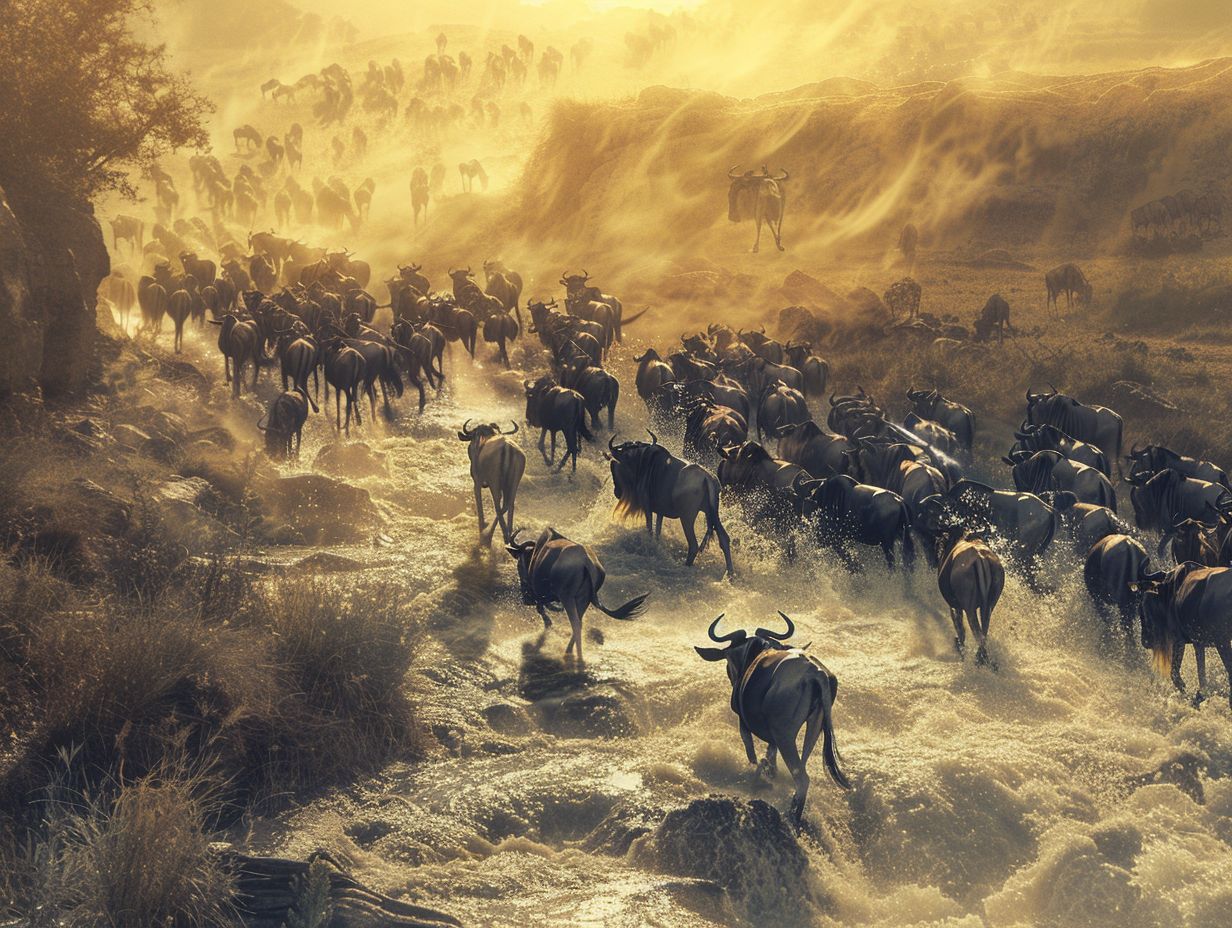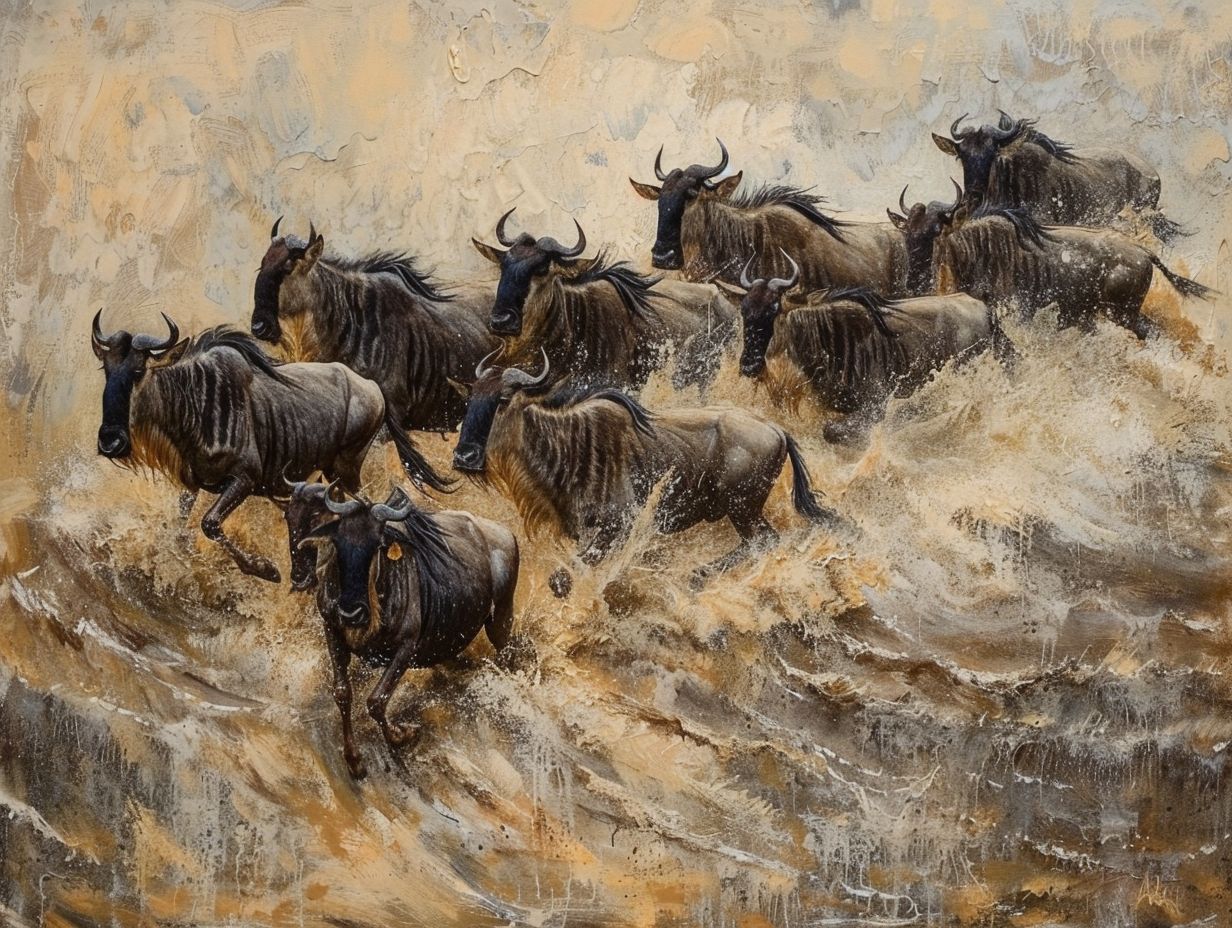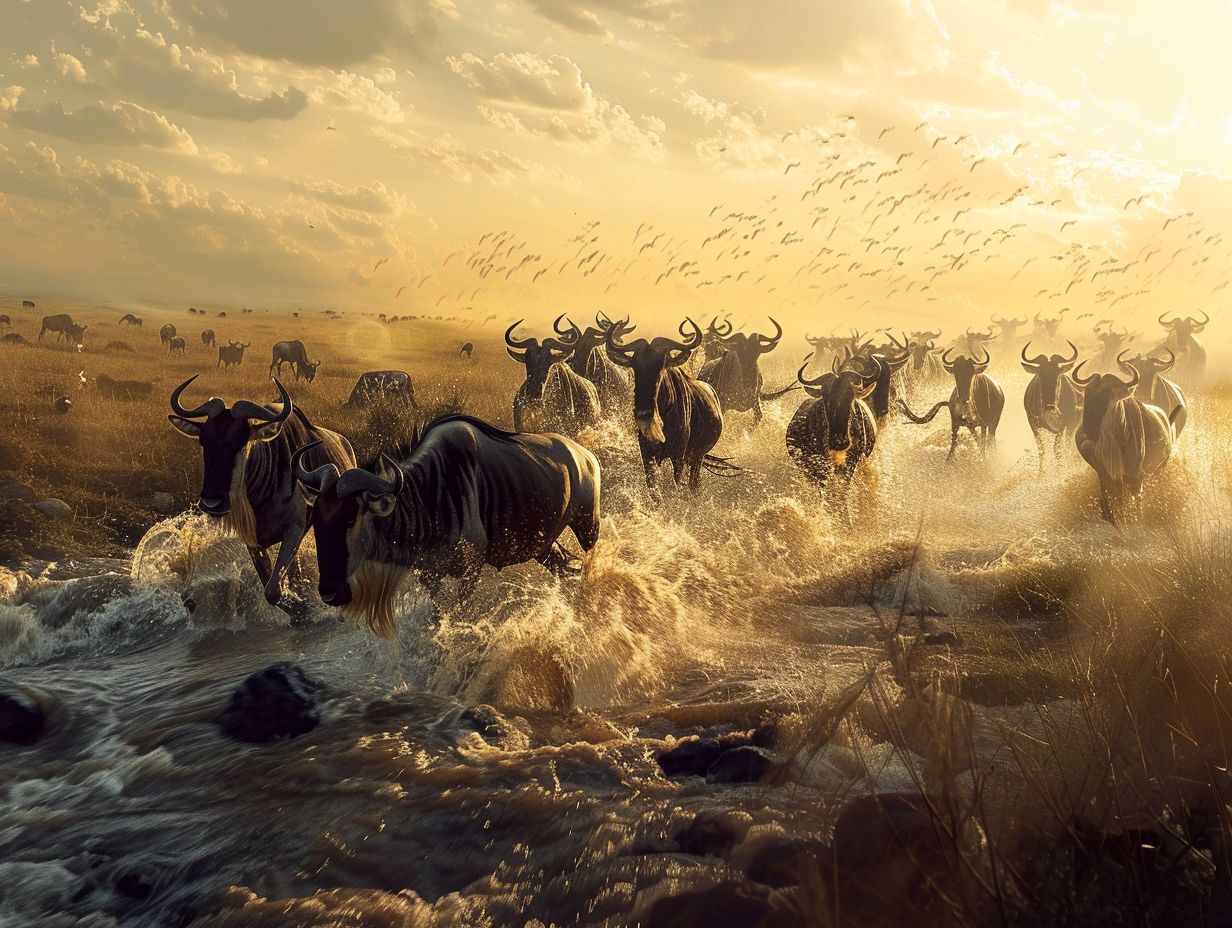
Wildebeest Migration
The Wildebeest Migration is one of the greatest wildlife spectacles on earth, involving millions of animals moving across the vast plains of East Africa.
We will explore where and when this epic migration takes place, as well as the main reasons behind it, such as food availability, breeding, and avoiding predators.
Delve into the animals involved, the challenging obstacles they face, and how you can witness this amazing event through safari tours, hot air balloon rides, and self-drive safaris.
Join us on a journey through the remarkable Wildebeest Migration!
Key Takeaways:

- The Wildebeest Migration is an annual event where millions of animals migrate in search of food, breeding opportunities, and to avoid predators.
- It takes place in the Serengeti National Park and Maasai Mara National Reserve, two of the most iconic destinations in Africa.
- The main reasons behind the migration include food availability, breeding and birthing, and avoiding predators. These factors drive the animals to travel long distances.
What Is the Wildebeest Migration?
The Wildebeest Migration is one of the most spectacular natural events where vast herds of wildebeest, zebras, and other animals move across the Serengeti ecosystem in East Africa.
This annual phenomenon involves approximately 1.5 million wildebeest, along with hundreds of thousands of zebras and gazelles, making it one of the largest terrestrial migrations on the planet.
The migration is a cyclical event driven by the search for fresh grazing lands and water sources as the seasons change. Maasai Mara National Reserve in Kenya and Serengeti National Park in Tanzania are key areas where this incredible journey unfolds.
Where Does the Wildebeest Migration Take Place?
The Wildebeest Migration primarily takes place in the Serengeti National Park in Tanzania and extends into the Maasai Mara National Reserve in Kenya, encompassing vast grasslands, rivers, and diverse ecosystems.
These regions are revered for their stunning landscapes, including the sweeping savannahs dotted with acacia trees that provide a picturesque backdrop to the migration. The Serengeti boasts the iconic Serena Lodge, offering panoramic views of the plains where the wildebeest traverse in a seemingly endless stream during their annual journey.
On the other hand, the Maasai Mara is known for the mighty Mara River, which poses a treacherous obstacle for the wildebeest herd as they brave crocodile-infested waters during their migration. Both areas play a crucial role in sustaining this natural spectacle that enthralls spectators and researchers alike.
When Does the Wildebeest Migration Occur?
The Wildebeest Migration typically occurs annually between the months of June and October, coinciding with the dry season and the Great Migration period when wildebeest herds undertake their journey in search of greener pastures.
During this period, over 1.5 million wildebeest, accompanied by zebras and gazelles, traverse hundreds of miles across the Serengeti National Park in Tanzania and the Masai Mara National Reserve in Kenya. This natural spectacle is not only awe-inspiring but also serves as a life-sustaining journey for these animals, allowing them to follow the rains and replenish their food sources.
One of the most remarkable phases of the Wildebeest Migration is the calving season, occurring from January to March, when thousands of wildebeest give birth to their young calves, attracting predators and creating a delicate balance of life and death. This mass movement of wildlife showcases the resilience and adaptability of these animals.
What Are the Main Reasons for the Wildebeest Migration?
The Wildebeest Migration is primarily driven by the need for food availability, breeding and birthing opportunities, and the instinct to avoid predators in the Serengeti ecosystem.
Every year, over a million wildebeests, zebras, and gazelles partake in this awe-inspiring journey across the vast plains of the Serengeti and the Masai Mara in search of richer grazing grounds.
Predators such as lions, cheetahs, and crocodiles lurk along the migration path, creating a constant sense of danger that fuels the instinctual drive of the animals to keep moving.
Environmental factors like rainfall patterns also play a significant role, influencing the timing and direction of the migration as the herds follow the availability of fresh grass and water sources.
1. Food Availability:
Food availability plays a crucial role in the Wildebeest Migration as the herds move in search of fresh grazing lands to sustain their journey and ensure their survival.
During the annual migration, the millions of wildebeest, along with zebras and gazelles, travel across the Serengeti in search of nutrient-rich grasslands.
2. Grazing patterns:
are essential as these animals depend on a diverse diet to meet their nutritional needs . The abundance of vegetation influences their movement, as they navigate through different ecosystems, impacting the overall migration process . The availability of food not only affects the physical well-being of the herds but also shapes the entire ecosystem they travel through.
3. Breeding and Birthing:
Breeding and birthing are significant aspects of the Wildebeest Migration, with the calving season being a critical period for the herds to ensure the survival of the young calves.
During this intense period, pregnant wildebeest mothers seek out safe and secluded areas away from predators to give birth.
The vulnerable newborns are then quickly assisted by their mothers to stand and start moving, as the herds continue their journey across the vast plains.”
4. Avoiding Predators:

Avoiding predators is a key survival strategy during the Wildebeest Migration, with wildebeest facing threats from lions on land and crocodiles during river crossings.
During the migration, wildebeest muster all their instincts to outmaneuver their formidable predators. The landscape becomes a battlefield where speed and group cohesion are their shields against the cunning tactics of the lions.
Instinctively, they form massive herds, moving like a synchronized wave across the savannah, making it challenging for predators to single out a target. When crossing treacherous rivers infested with hungry crocodiles, their sheer numbers create safety in unity, minimizing the chances of individual attacks.
What Animals Are Involved in the Wildebeest Migration?
The Wildebeest Migration involves a diverse array of animals including wildebeest, zebras, and gazelles, creating a dynamic ecosystem interaction during their journey.
These animals, in their thousands, move across East Africa’s plains, crossing rivers and traversing vast savannas in search of fresh grazing lands. Each species contributes uniquely to the migration process; the wildebeest rely on zebras to lead the way to water sources while gazelles use their agility to navigate through potential dangers.
Predator-prey relationships also come into play, with lions, cheetahs, and crocodiles capitalizing on the abundance of food during this annual phenomenon.
1. Wildebeest:
Wildebeest are the primary participants in the migration, undertaking a challenging journey across vast landscapes to ensure their survival in changing environmental conditions.
These remarkable creatures, also known as gnu, exhibit fascinating behaviors during their migration. They form massive herds that can number in the millions, a strategic move to safeguard against predators in the wild savannas.
Adaptive strategies such as synchronized birthing coincide with the arrival of rich grazing lands, ensuring the survival of their offspring. Wildebeest follow well-established migration routes, navigating obstacles like rivers and hostile terrain with a remarkable sense of direction and resilience.
2. Zebra:
Zebras play a crucial role in the Wildebeest Migration, moving alongside wildebeest herds and utilizing their survival instincts to navigate through grasslands and evade predators.
Zebras and wildebeests form a symbiotic relationship during the migration, with zebras being the first line of defense against potential predators due to their keen eyesight and strong herding instincts.
The zebras’ black and white stripes act as a form of camouflage, creating an optical illusion that confuses predators, making it challenging for them to single out an individual zebra from the herd. Zebras’ grazing patterns complement those of wildebeests, as zebras consume the longer grass at the top, while wildebeests focus on the lower grass.
This ensures efficient land utilization and helps maintain a balanced ecosystem.
3. Gazelles:
Gazelles are part of the wildlife spectacle during the Wildebeest Migration, contributing to the herds’ safety in numbers and showcasing their agile movements across the savannah.
These elegant creatures play a crucial role in the ecosystem, often acting as the early warning system for potential dangers. Their keen senses enable them to detect predators from afar, alerting the rest of the group with their distinctive alarm calls.
Group dynamics among gazelles are fascinating to observe; they tend to form cohesive units that provide mutual protection. When one detects a threat, others quickly follow suit, creating a synchronized response that enhances their survival chances significantly.
What Is the Route of the Wildebeest Migration?
The route of the Wildebeest Migration spans from the Serengeti National Park in Tanzania to the Maasai Mara National Reserve in Kenya, encompassing a challenging and awe-inspiring journey across diverse landscapes.
The journey commences with the vast plains of the Serengeti, where hundreds of thousands of wildebeest graze on the rich grasslands before embarking on their trek northward. As the herds encounter the Grumeti River, they face the treacherous crossing, battling strong currents and lurking crocodiles.
Moving further, the Mara River stands as another formidable obstacle, demanding courage and strength from the migrating animals. Despite the perils, this migration is a spectacle of resilience and survival, showcasing the cycle of life in the interconnected ecosystem.
1. Serengeti National Park:
Serengeti National Park serves as a critical starting point for the Wildebeest Migration, providing diverse ecosystems, grasslands, and habitats for wildlife as they embark on their annual journey.
The park’s vast plains are a cornerstone of the migration route, offering an abundance of grazing opportunities for the thousands of wildebeest, zebras, and other herbivores that partake in this epic journey.
The ecological significance of this area cannot be overstated, as it supports a delicate balance of predator-prey dynamics, with the big cats like lions and cheetahs following the herds, ensuring the natural order of life in the savannah.
2. Maasai Mara National Reserve:

Maasai Mara National Reserve marks a crucial stage in the Wildebeest Migration, offering vital water sources, river crossings, and diverse habitats for wildebeest and other animals during their journey.
Located in Kenya, this reserve is renowned for its picturesque landscapes, encompassing vast savannah plains and lush forests that provide a haven for countless species.
The Mara River, flowing through the reserve, becomes a challenging obstacle for the migrating herds, creating dramatic scenes as they attempt daring crossings. These crossings not only showcase the resilience of the wildebeest but also attract predators like crocodiles and lions, adding a thrilling element to the migration process.
The Maasai Mara plays a critical role in sustaining wildlife populations, ensuring the survival of various species in this dynamic ecosystem.
What Are the Challenges Faced During the Wildebeest Migration?
The Wildebeest Migration poses numerous challenges including river crossings fraught with danger, encounters with predators, and the constant struggle for survival in the African savannah.
One of the greatest obstacles faced by the wildebeest during their migration is the treacherous river crossings. These crossings are not just a physical hurdle but a test of their strength and determination. The Mara River, with its strong currents and lurking crocodiles, presents a formidable challenge.
Predator threats add another layer of complexity to their journey, with lions and hyenas always on the prowl. To survive, these animals need to rely on their instincts and the safety of the herd. Only the fittest and most adaptable individuals manage to endure the harsh conditions of the African wilderness.
1. Crossing Rivers:
Crossing rivers is a perilous aspect of the Wildebeest Migration, as herds brave crocodile-infested waters to reach greener pastures on the other side, testing their survival instincts and resilience.
These water crossings present numerous challenges to the migrating herds. The lurking presence of crocodiles adds a constant element of danger, as these predators wait for the opportune moment to strike.
The vulnerability of the young and weak is especially pronounced during these crossings, making them easy targets for the swift and cunning reptiles. The crossings impact the wildlife populations significantly, influencing the ecosystem balance near riverbanks.
2. Predators:
Predators such as lions pose a constant threat to wildebeest herds during the migration, with ambushes and hunts challenging the survival instincts of the animals in the vast African savannah.
The interaction between lions and wildebeests plays a crucial role in the predator-prey dynamics within the ecosystem. Lions, as apex predators, rely on the migration for sustained hunting opportunities, while wildebeests have evolved strategies to evade these skilled hunters, such as staying in large groups and being vigilant.
Predation is a natural mechanism that helps maintain a balanced ecosystem by controlling herbivore populations and influencing grazing patterns. The intensity of predation during the Wildebeest Migration not only shapes the behavior of these animals but also has cascading effects on other species in the ecosystem.
3. Human Interference:
Human interference in the Wildebeest Migration, through the presence of safari camps, lodges, and tourist activities, can disrupt the natural rhythms of the ecosystem and impact the behavior of migrating herds.
This disruption can lead to changes in migration patterns, as the wildlife may alter their routes to avoid areas of high human activity. The construction of roads and fences can block traditional migration routes, forcing the herds to navigate unfamiliar territories, resulting in increased stress and risk of predation.
- The noise and disturbance caused by human presence can interrupt important mating and grazing behaviors of the wildebeest.
- Infrastructure development, such as dams and urban expansion, can fragment habitats and disrupt the flow of water sources crucial for the survival of the migrating herds.
How Can You Witness the Wildebeest Migration?
You can witness the awe-inspiring Wildebeest Migration through immersive safari tours, thrilling hot air balloon rides, or adventurous self-drive safaris that offer unique perspectives on this natural spectacle.
Each viewing method provides a distinct encounter with the mass movement of wildebeests and zebras across the vast plains of the Serengeti and Maasai Mara.
Embarking on a guided safari tour allows you to benefit from the expertise of experienced guides who can navigate you to prime viewing spots and share fascinating insights about the wildlife behavior.
For a bird’s eye view of the migration, consider booking a hot air balloon ride, where you can marvel at the sheer scale of the herds and capture breathtaking aerial photographs.
If you prefer a more independent adventure, opt for a self-drive safari, giving you the freedom to set your pace and explore off-the-beaten-path areas at your leisure.
1. Safari Tours:
Safari tours offer an up-close and personal encounter with the Wildebeest Migration, allowing visitors to stay in camps and lodges strategically located to witness the movement of herds in the Serengeti and Maasai Mara.
The accommodations provided on these safari tours range from luxurious tented camps to rustic lodges, ensuring a diverse experience for travelers of all preferences.
Guided excursions led by seasoned naturalists and trackers enhance the adventure by offering valuable insights into the behavior and migration patterns of wildebeests, zebras, and other wildlife in the region.
Immersed in the vast savannas, visitors have the opportunity to witness dramatic river crossings, where crocodiles lurk, and predators like lions and cheetahs await their prey with precision.
2. Hot Air Balloon Rides:

Hot air balloon rides offer a unique perspective of the Wildebeest Migration, allowing passengers to soar above the savannah and witness the vast herds from an aerial view, providing an unforgettable experience of the natural spectacle.
The panoramic views from high above unveil the expanse of the grasslands, dotted with migrating wildebeests as far as the eye can see. This bird’s eye view immerses travelers in the grandeur of the Great Migration, a mesmerizing sight that unfolds beneath the vibrant hues of the African sky.
The minimal environmental impact of ballooning ensures a sustainable way to admire this wildlife phenomenon without disturbing the animals’ natural habitat.
3. Self-Drive Safaris:
Self-drive safaris offer a sense of adventure and freedom in exploring the Wildebeest Migration, allowing travelers to navigate their own routes, discover hidden gems, and witness the wildlife spectacle at their own pace.
Embarking on a self-drive safari not only provides an unforgettable journey but also grants you the flexibility to decide the timing of your wildlife encounters along the way.
Imagine stopping at a picturesque spot to watch the wildebeest herds crossing the Mara River just as the sun begins to set. This level of autonomy enriches the safari experience, creating a deep connection with the natural world and wildlife that cannot be replicated in a guided tour.
Frequently Asked Questions:
1. What is the Wildebeest Migration?
A: The Wildebeest Migration is an annual phenomenon where millions of wildebeest, zebra, and other grazing animals cross the Serengeti in Tanzania and the Maasai Mara in Kenya in search of fresh grazing land.
2. When does the Wildebeest Migration occur?
A: The Wildebeest Migration typically occurs between the months of July and October, depending on the rainfall patterns in the region.
3. Why do wildebeest migrate?
A: Wildebeest migrate in search of greener pastures and better water sources. This is a natural instinct for survival as they follow the rainy season and the growth of new grass.
4. How far do wildebeest migrate?
A: The Wildebeest Migration covers a distance of approximately 1,800 miles (2,900 km) as the animals make their way from the Serengeti in Tanzania to the Maasai Mara in Kenya.
5. What other animals are involved in the Wildebeest Migration?
A: Aside from wildebeest, zebras are also a major part of the migration. Other herbivores such as gazelles and elands may also join in the journey.
Is the Wildebeest Migration dangerous for the animals?
The Wildebeest Migration can be a dangerous journey for the animals as they face predators such as lions, hyenas, and crocodiles. However, it is a natural and necessary cycle for the wildebeest’s survival.